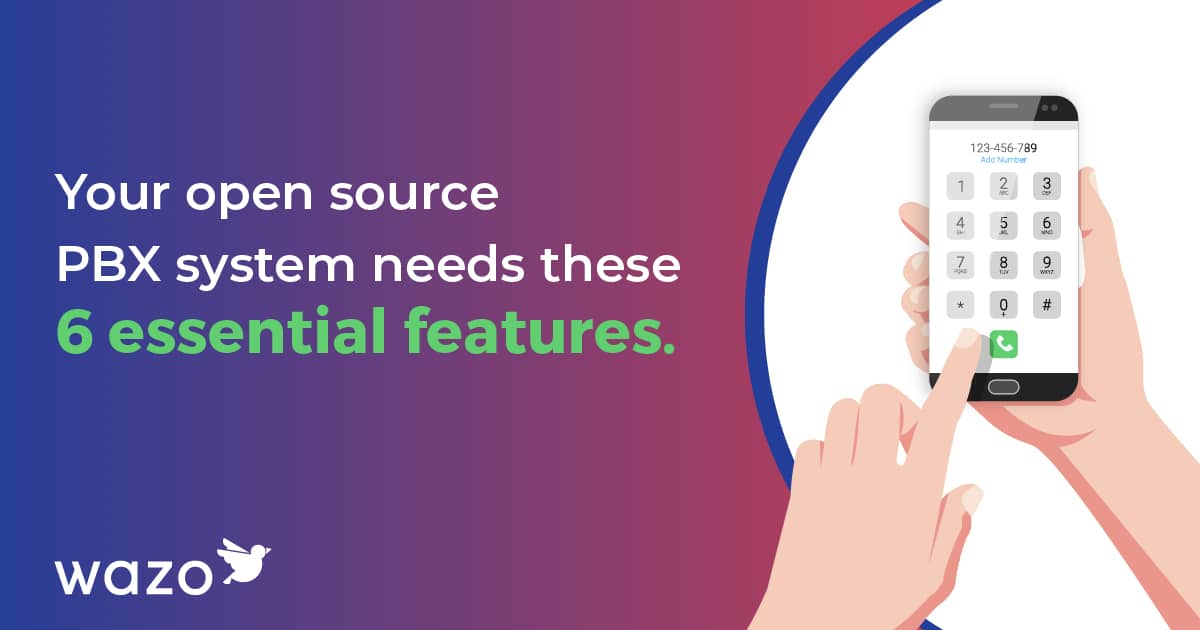Are you looking to upgrade your outdated, legacy phone syste.m? With an open-source PBX platform, you can design a phone system that meets your company’s unique needs. Plus, the right system will provide all of the calling features your teams need to stay connected and productive. Below, we’re sharing the calling features your PBX system should include so you can make the best choice for your business.
What Are Open Source PBX Systems?
Before exploring the features your PBX solution needs, we’re answering the question: what exactly is open-source PBX?
Open-source PBX platforms are phone systems built on open-source software. This means the source code is freely available for use with a general public license. Many popular open-source PBX software solutions are originally based on the Asterisk platform. Asterisk is an open-source software PBX that can run on several versions of the Linux operating system and macOS.
IP PBX solutions have been around for over 20 years, but software-based PBX solutions have gained popularity in recent years thanks to their scalable and modular design. This flexibility enables companies to customize their business phone systems to their specific needs. There’s also a community of developers who contribute to the software’s ongoing development. Lastly, open-source PBX platforms can be a low-cost alternative to closed PBX systems.

What Features Should You Look For in an Open Source PBX System?
A PBX system can handle both IP phones (modern desk phones) as well as softphones by combining SIP trunks with an open-source PBX platform. Each open-source PBX solution offers its own set of enterprise telephony features. Choosing the ones that would best suit your business is essential. The features you’ll see in some of the most popular open source PBX software solutions include:
1. Interactive Voice Response (IVR)
IVR is a phone system feature that helps companies create a better customer experience by setting up automated interactions with callers. These automated interactions can provide information and route callers to the right teams at call centers. Modern IVR systems often incorporate natural language processing, which allows callers to speak in a more natural way. Some also include visual IVR, which enables callers to interact with call centers using a graphical interface on their mobile devices.

2. Audio and Video Conferencing
Audio and video conferencing are some of the more popularly used calling features since the pandemic. Creating dedicated conference rooms simplifies the way you engage with your employees and customers. Audio and video conferencing are helpful for enabling employees to collaborate and communicate from anywhere.
3. Call Recording
Call recording is an important feature in an IP PBX phone system. It allows businesses to monitor the quality of customer service their employees provide. This can help identify areas for improvement and provide training opportunities in call centers to improve customer satisfaction. Call recordings can also serve as evidence in legal disputes, help protect businesses from liability, and meet compliance requirements.
4. Ring Groups and Call Queues
Ring groups help to ensure the right teams respond your incoming calls to improve customer satisfaction and streamline communication. With ring groups, you can route calls based on criteria that make the most sense for your business. Essentially, this feature helps to ensure your call centers are as efficient as possible.
Call queues serve a similar customer satisfaction function. To minimize hold time, an intelligent system will group callers into the appropriate queue for the appropriate type of agent based on the nature of the call.
5. Executive Assistant
One IP PBX feature gaining ground is an executive assistant. This allows you to delegate calls between managers and executive assistants using a streamlined workflow. With this feature, you can assign another team member to handle incoming calls, manage call volume, screen calls, and more.
Some popular open source PBX software solutions also enable this feature via a mobile client. This makes it even easier to support remote and hybrid work.
6. Virtual Fax
Fax isn’t dead yet, and modern IP PBX systems offer a modern, paper-free fax experience. Virtual fax features enable you to send fax messages in PDF format and receive responses in your inbox. Basically, you’ll never have to waste time or money on outdated fax machines again.
7. Call Parking
The call parking feature allows you to place an active call on hold without tying up the original phone line. From there, any agent with access to the parked call can pick it up. This prevents bottlenecks during high call volume periods, and creates a more positive customer experience.
Other Uses for Open Source PBX
Two technologies that are commonly used for voice and video communications are SIP H.323 and WebRTC. SIP is widely used for setting up and managing voice and video calls over IP networks. H.323 was developed for multimedia communication over networks that are not based on IP. While SIP is more popular, some organizations still use H.323 for legacy equipment.
WebRTC is also rapidly gaining popularity. Unlike SIP and H.323, WebRTC is a web-based technology that enables real-time communication between browsers. It’s another popular feature that can be bolted onto a UCaaS platform using an open source PBX software solution.
Modernize Your Organization With Wazo’s Open Source PBX Platform
Wazo helps businesses deliver unique communication experiences. Our custom, off-the-shelf UCaaS platform supports the needs of MSPs – and your customers. Our solution lets you create the phone system you’ve been waiting for on a flexible open-source PBX platform.
Contact Wazo today to get started with a free demo of our open source PBX platform.


